According to statistics, almost half of all visits to the dermatologist, in one way or another, are related to fungal diseases. You can catch an infection when you visit a swimming pool, sauna, visit the beach or walk in your host's slippers. Find out everything about how to recognize toenail fungus without scratching or using other diagnostic methods - symptoms of onychomycosis in the initial and chronic stages of the disease.
What is toenail fungus
Yeast fungus
They are in the second place in the frequency of occurrence of mycoses of the feet. The disease is provoked by two types of pathogens of the genus Candida:
- White candida (Candida albicans) - most often appears on the fingers, as a complication of existing onychomycosis caused by dermatophytes.
- Parapsilosis (Candida parapsilosis) - affects the nail plate from the edge. The initial symptoms are characterized by the appearance of black spots on the tip of the finger, which gradually increase in size. Candida parapsilosis often completely destroys the nail plate.
mold
This type of fungal infection is not particularly common - only three patients who sought help from a dermatologist suffered from it. There are several types of mold pathogens:
- Scopulariopsis - often infects previously injured big toes.
- Aspergillus or black mold - infection with onychomycosis is possible only for people with reduced immunity. The main symptom of the disease is the deformation of the nail plates and the appearance of normotrophic black dots.
- Fusarium - this onychomycosis is very rare, since pathogens live in agricultural crops. Infection of a person is possible only if there are open wounds, scratches or cracks on the leg.
Dermatophytes
The primacy among the causative agents of onychomycosis is occupied by dermatophytes, of which the feet are most often affected:
- Red Trichophyton (Trichophyton rubrum) - develops on the lateral and distal surface. The main symptoms in the initial stages of development are yellow spots or white stripes. Without specific treatment, fungal spores can spread throughout the body and cause severe skin lesions.
- Mentagrophytes (Trichophyton mentagrophytes) - cracks appear in the interdigital spaces, severe pain during movement. Without proper therapy, it spreads to the nails; Fungus can especially often affect the big toe and little toe.
- Epidermophyton floccosum - in the initial stage affects the skin of the fingers. Toenail fungus appears in the form of peeling feet, accompanied by itching and increased sweating of the toes. Without treatment, epidermophyton leads to atrophy.
What do toenail fungus look like?
Today in medicine, two classifications of onychomycosis are used: the first - according to the type of pathological changes, and the second - depending on the location. According to the type of fungal infections, all types are divided into four subtypes: marginal, normotrophic, hypertrophic and atrophic. According to the form of localization, there are several other types of diseases:
- distal - when only the lip suffers from fungus;
- lateral - pathological processes begin near the ridges of the skin;
- proximal - the change affects the lower part;
- superficial white onychomycosis - white spots or streaks appear.
Regional onychomycosis
This is the initial stage of the fungus, which is very difficult to identify on your own. This type of mycosis is associated with changes at the edge of the nail plate, which are visualized by the appearance of narrow gray lines. Over time, the symptoms of nail fungus intensify: the color begins to fade, fragility appears, while the thickness of the plate remains the same. Sometimes gray-yellow spots may appear.
Normotrophic
This type of onychomycosis is manifested in a decrease in gloss, but with the preservation of the thickness of the hard part of the finger. The main symptoms of the normotrophic type are:
- increased fragility;
- loss of luster;
- the appearance of white or gray-yellow spots on the entire surface of the nail;
- the bed is visually divided into sectors;
- Gray mucus gradually starts to come out from under the nail.
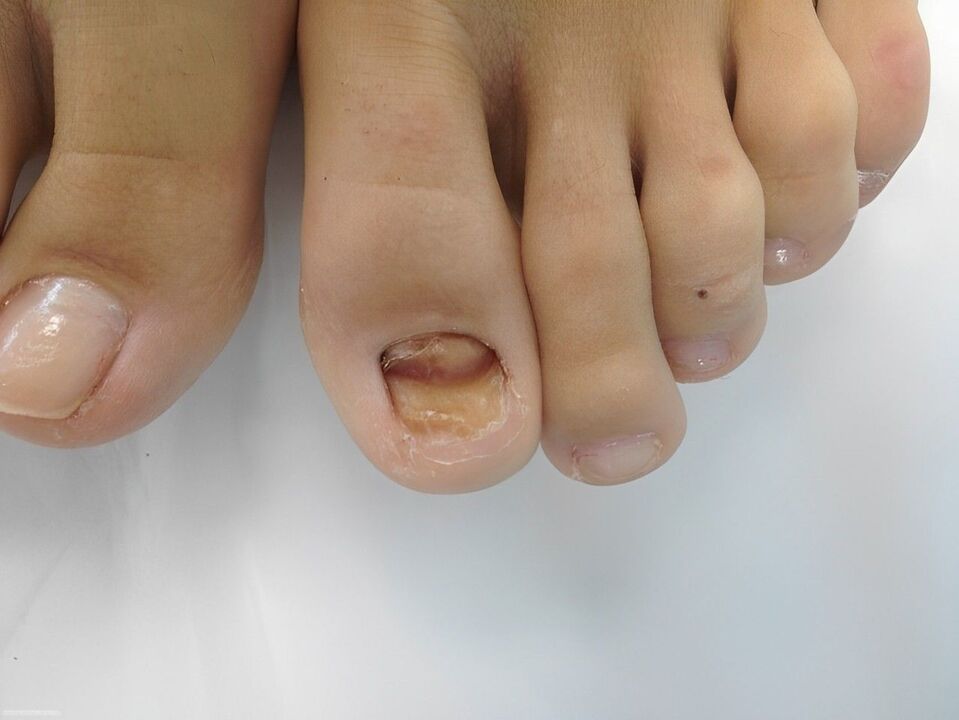
Hypertrophic
This has a specific symptom - the formation of atrophy along the edge. Hypertrophy leads to thickening of the nail plate and the appearance of an atypical pattern. Patients often complain of pain, especially when walking, which goes away only after taking painkillers. Hypertrophic mycosis has three stages:
- Total - a massive lesion that affects the thickness of the nail plate.
- Lateral - appears on the side parts.
- Distal - the infection is localized under the free part of the bed.
The shape of the white surface
This type of fungal infection is characterized by the appearance of small foci of infection in the center or on the edge of the nails, white or almost white. This type of onychomycosis occurs only on the feet. Due to the fact that the spores affect only the upper part of the finger, the plate itself is very rarely deformed, but its upper layers and epidermis suffer from the fungus. If left untreated, the hard part becomes loose and rough. As a rule, superficial onychomycosis is caused by dermatophytes.
Onycholithic
It is accompanied by detachment of a part of the plate from the soft nail bed. The affected nail becomes dull with gray spots and gradually loses its luster. As a rule, this type of fungus manifests itself as a complication of hypertrophic or normotrophic mycosis. In the absence of proper treatment, areas covered with hyperkeratosis may appear at the site of the lesion.
Candidal onychomycosis
It is often combined with damage to healthy periungual tissues. Pathology usually appears on the third or fourth finger. Candidal mycosis is characterized by the following symptoms:
- lack of skin at the nail growth line;
- fragility and crumbling of the edges of the plate;
- the appearance of transverse stripes at the base of the bed;
- inflammation of skin ridges;
- brown-brown color of the nail plate;
- soft tissue pain.
Proximal deformity
One of the rarest forms of onychomycosis. The disease often begins to develop from soft tissues, gradually moving to a healthy nail. Fungal growth starts from the middle of the nail. Without treatment, the plaques change color, begin to crumble and peel off. The causes of the proximal-deforming form are: red trichophyton and mentagrophytes.
Atrophic
This form of the unpleasant disease is characterized by a change from normal color to gray-brown. In this case, the symptoms appear gradually: first, the plaque loses its shine and becomes dull, then the nail is destroyed and loose accumulations of small skin flakes are visible at the bed site. Pathological processes start from the outside, eventually covering the growth area and skin folds.
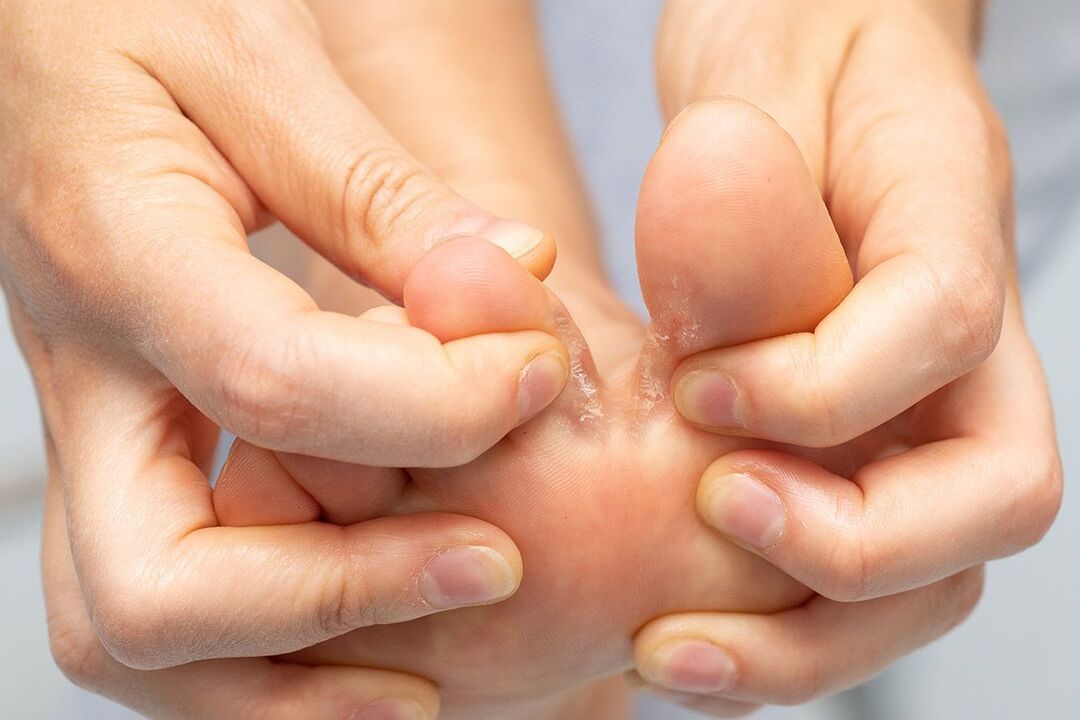
Types and stages of fungal infection
Signs of fungal infection depend on the form of the disease and its severity. The first signs of pathology may not be noticed, but already at an average level the plate is clearly deformed, it becomes thick and its structure is heterogeneous. Such signs cannot be ignored, as the next stage is dystrophic, the nail may collapse completely, inflammatory processes begin in the periungual ridges and a secondary infection occurs.
The main forms of the disease:
- Lateral onychomycosis is the most common type of fungus. The first signs of fungus appear on the free edge of the nail in the form of a small yellow spot. As the disease progresses, the plaque thickens, deep cracks can form on it, and discomfort appears when walking. This form of fungal pathology is difficult to treat.
- Superficial white onychomycosis - pathogenic microorganisms affect only the upper layers of the nail. The plaque does not thicken, but over time it becomes loose and resembles foam in structure. Treatment is not difficult and improvement in well-being occurs quickly.
- Subungual onychomycosis is a rare form of pathology. Symptoms of the fungus appear in the form of thickening of the skin in the area of the nail fold, the nail becomes completely white and dark.
There are a number of diseases that show symptoms similar to fungal infection - psoriasis, eczema, lichen planus. Changes in the structure of the nail occur after injuries or bruises. Only a doctor can make an accurate diagnosis after a complete diagnosis.
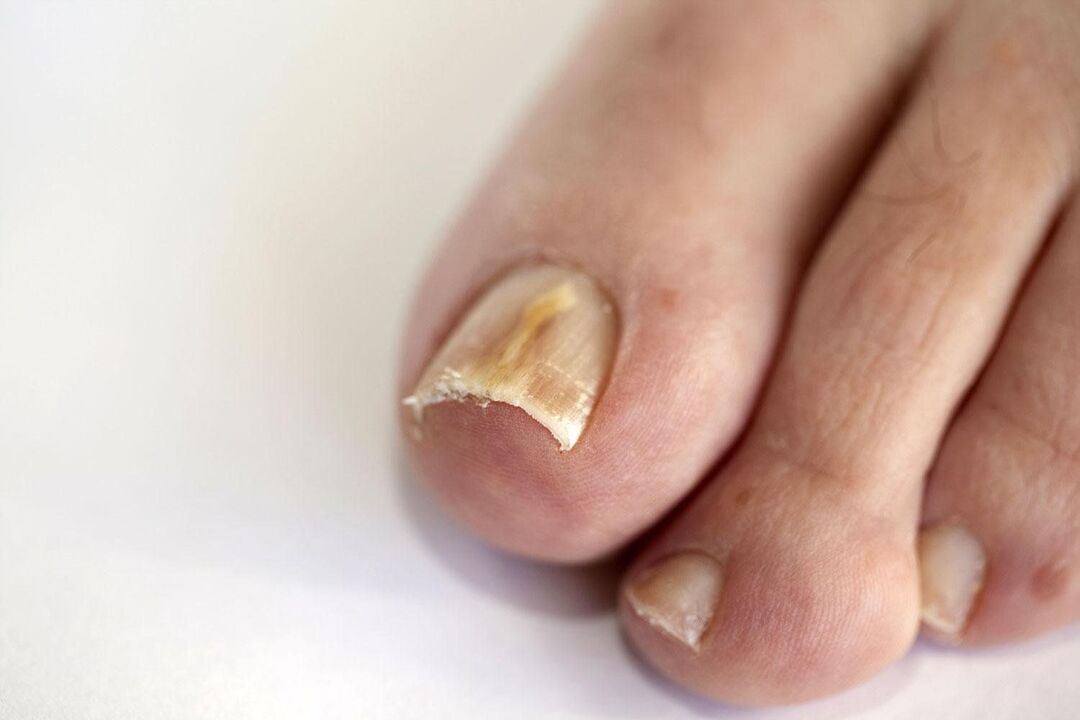
How to identify toenail fungus - common symptoms
Depending on the stage of the disease, complete atrophy and partial hypertrophy are distinguished, and the two concepts are related, but not synonymous. The atrophic type refers to damaged growth, thinning and complete destruction of the nail plate - this is the stage of total damage. Often, when an advanced stage is detected, patients complain to the dermatologist not only about changes in structure, but also about severe pain.
Hypertrophic toenail fungus - symptoms:
- acquires a yellow tint along the edge of the plaque or white inclusions appear near the growth area;
- deformed - waves, tubercles and other irregularities appear;
- the pad becomes red, peels and swells as the infection grows;
- begins to exfoliate, leaves the bed;
- Small cracks and sometimes blisters appear between the toes.
Itching and burning
Very often the disease manifests itself in the legs in the form of severe itching. This feeling begins to bother the patient in the first days after infection. If the fungal spores attack the plaque, itching is felt around the affected area, while the skin becomes smooth, dry and peeling, and irritation appears. If the infection started from the soft tissues, the fingers themselves itch. When the skin is scratched hard, the itching is followed by a burning sensation. As a rule, these symptoms appear with lesions of the legs, less often with onychomycosis of the hands.
Loss of natural color
This is another symptom of onychomycosis, which replaces or complements itching. In this case, the color will depend on the type of pathogen that has settled in the human body:
After entering the fingers, fungal spores begin to multiply actively and gradually cover the entire space, slowly leading to complete deformation and destruction of its hard part. The plaque thickens or, conversely, becomes very thin, begins to crumble, and an unnatural yellowness and white layer become visible. In the initial stages of infection, the very structure of the nail plate changes - it becomes bumpy or covered with stripes, and the shade of the plate becomes cloudy.
Doctors distinguish three main stages of fungal infection:
- The color turns yellow and grooves appear. When you try to trim the edge, the top starts to crumble. Sometimes an unpleasant smell may appear.
- The finger completely changed color, became dull and cloudy, and strange inclusions appeared. Jaundice begins to darken, black lines appear, and areas of green color may appear. Cutting affected nails becomes very difficult.
- The whole nail has changed - it has become significantly thicker, it is impossible to trim the edge without softening.
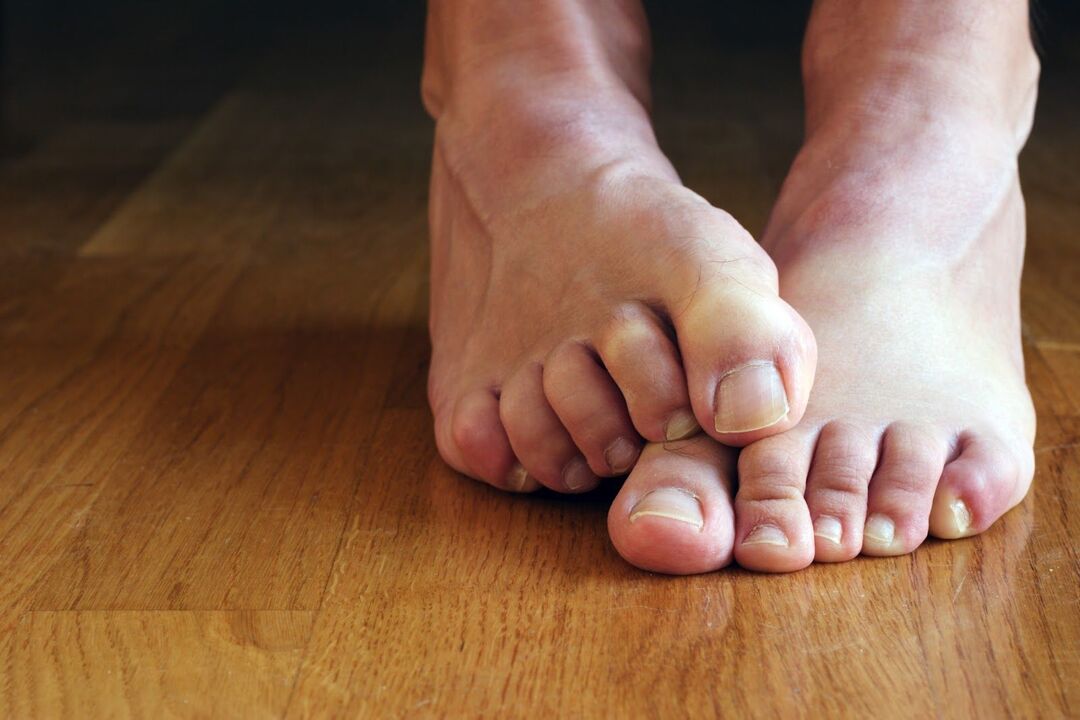
Pain in the nail area
Discomfort with nail fungus is not a typical concept for every patient. Some patients may not experience such symptoms at all, especially if the disease is detected at an early stage. With an advanced form of fungal infection, it is easy to recognize the pathology: the fingers lose their original appearance, begin to fall off and peel off. At this stage, some patients may feel pain under the nail or in the fingers.
Painful sensations with mycosis of the fingers can occur for several reasons:
- Due to the fact that the affected areas become thicker, lose their original appearance and are deformed. In this case, even the most worn shoes cause noticeable discomfort while walking. As a result, pain can bother you not only during a walk, but also after taking off your shoes.
- As the spores spread, the fungus captures more and more new territories. When it enters the soft tissue of the nail, the infection often affects the nerve endings, causing pain, paroxysmal or throbbing pain. If a symptom appears for this reason, the discomfort may appear even at rest.
- One of the signs of athlete's foot is the appearance of small cracks and blisters between the toes. The skin may become very red and inflamed and the fingers may swell. Due to the fact that the area between the toes in closed shoes sweats a lot, such wounds on the feet heal very slowly and constantly hurt.
How does toenail fungus start?
Loss and change of color, appearance of unevenness, thinning or thickening of the plate, distortion - these are the first signs of toenail fungus that fit the general description. However, with careful self-diagnosis of the disease, it can even be classified. P. sh.
- Infection with dermatophytes starts from the free edge of the plaque. The appearance of the fungus is indicated by a small yellow spot and a crumpled surface.
- Yeast-like fungi are characterized by a proximal form - when the infection begins at the base. The main symptom of candidiasis-type onychomycosis is inflammation of the periungual fold, separation of the cuticle, pain when pressing.
- Fungi turn fingers green, brown or black. Mold infection appears as spots, small dots or longitudinal plaques.
The first signs that you have toenail fungus are the symptoms that appear in the adjacent soft tissues. The skin of the feet loses its natural color, becomes red or yellow, thins and hurts easily. As a rule, this is where the mushroom process begins. Over time, the disease can cause serious discomfort - provoke the appearance of deep cracks, itching and fluid blisters.
Symptoms of fungal nail infections
In the initial stage of infection, toenail fungus is almost invisible and does not cause discomfort (see photo). Then characteristic symptoms of fungal infection appear:
- the surface of the nail plate on the fingers acquires an unpleasant cloudy shade;
- the nail plate begins to peel off, separating from the nail bed;
- the diseased nail loses its original shape, thickening and taking on an irregular appearance;
- cracks gradually form between the fingers; the person begins to feel pain in the area of the damaged nail;
- the skin on the fingers begins to peel;
- Itchy skin appears between the toes.
Nail fungus should be treated, preferably in the early stages. In this case, you can get by only with external preparations: ointments, varnishes and folk remedies. In a more advanced form, you will need to take antifungal tablets, in which case you will not be able to quickly get rid of the fungus on your feet.
What is dangerous about untreated onychomycosis?
In addition to the unpleasant external manifestations of this disease, fungi are a pathogenic microbe that causes damage to the entire human body:
- Untreated nail fungus opens the door to other infections.
- In addition, the fungus can act as an allergen and ultimately provoke hypersensitivity to nail fungus as an allergen.
- Onychomycosis complicates the course of many diseases, for example, diabetes.
- In particularly severe cases, against the background of a long course of the disease or reduced immunity, a fungal infection can cause deep mycosis - the penetration of fungi into the internal organs through the blood.
To avoid complications, you should start treatment quickly if you notice the first signs of fungal nail infection.
How to get rid of toenail fungus?
Medicines used to treat nails affected by fungus are presented in two groups.
- The first group is the local means of influence. This group includes medicated paints and peeling patches, ointments and creams and gels. Most of the drugs for external use are effective only in the initial stage of the disease.
- The second group consists of systemic antifungal drugs that are taken orally. Usually these are capsules or tablets that have an inhibitory effect on fungi. They block the spread of mycosis and have a prolonged effect, which significantly reduces the possibility of a relapse of the disease.
But considering that the drugs used to treat onychomycosis are very toxic and often cause side effects, and the clinical picture of fungal infections of the skin and nail plate on the fingers is always strictly individual, it is better to give an answer to the question thathow to cure toenail fungus an experienced specialist.
Laser therapy
If the advanced form of the fungus cannot be treated with drugs, you can turn to laser therapy.
- Laser treatment of fungus is considered one of the most effective ways to get rid of this disease.
- Under the influence of the beam, the fungal cells die immediately.
- The laser beam does not damage nearby tissues.
- An advanced form of fungus can be cured in just four laser therapy procedures.
Once you have decided to undergo laser treatment, it is also important to take all the necessary pills and vitamins at the same time.

Drug therapy for onychomycosis
The specialist prescribes the treatment in the initial stages of nail fungus taking into account several factors:
- Rate of plate change;
- Stages of hyperkeratosis;
- Area of damage;
- Clinical form of pathology.
At the beginning of the development of the disease, the dermatologist prescribes local remedies. These include ointment, varnish, solution, cream with antifungal (antifungal) properties. Their application is recommended after treating an infected nail. Preparative actions improve the access of drugs to the interior of the plaque, thus accelerating the therapy of the fungus.
To soften the nail, you can use patches containing urea or salicylic acid:
- Using a nail file, carefully process the nail plate;
- Apply an antifungal agent;
- Cover the nail with a bandage;
- Remove it after a day;
- Apply an antifungal medication prescribed by a dermatologist.
The specialist most often prescribes only medications for external use.
Careful!
Systemic antifungal agents are not used for onychomycosis in the initial stage of development.
Treatment of nail fungus at home
In the initial stage of the disease, you can try using proven folk remedies at home.
- Apple cider vinegar. Simply soak your feet 1-2 times a day in a 1: 1 mixture of apple cider vinegar and warm water for about 15-20 minutes. After soaking, let your nails dry completely (you can use a hair dryer). And in about two weeks you will notice that the fungus goes away and a beautiful and new one grows in place of the old damaged nail.
- Tea tree oil should be applied to the skin and nails affected by the fungus three times a day. A single dose is from 4 to 10 drops of the products. This treatment should be continued for at least two weeks, or longer, to ensure that the infection does not return. This oil should not be used by children or pregnant women.
- The freshly picked celandine is passed through a meat grinder and the juice is squeezed out of the resulting pulp (this is done through 3-4 layers of cheesecloth). It should yield approximately 200 ml. liquidCombine with 200 ml. 70% alcohol and leave for 24 hours. The prepared liquid is used for painting the affected nails, but the treatment is carried out only after you have steamed your feet for 10 minutes and dried them completely. The course of treatment is 10-12 days, 3-4 treatments per day.
- Another way to eliminate nail fungus is to treat them at home with iodine. It's very easy. For three weeks, the nail plate is coated with iodine every day. In this case, the growing tip of the damaged nail is regularly removed.
- Kombucha will also help fight fungus. Compresses are made for this treatment: wrap a plate of kombucha in cellophane and wrap a bandage around the leg, then put on socks. In the morning, you should wash your feet with warm water, carefully remove the dead areas and smear them with iodine. Side effects include quite strong pain, but the desired result can be achieved much faster.
If folk remedies do not give the desired result, you should contact specialists to prescribe complex therapy.
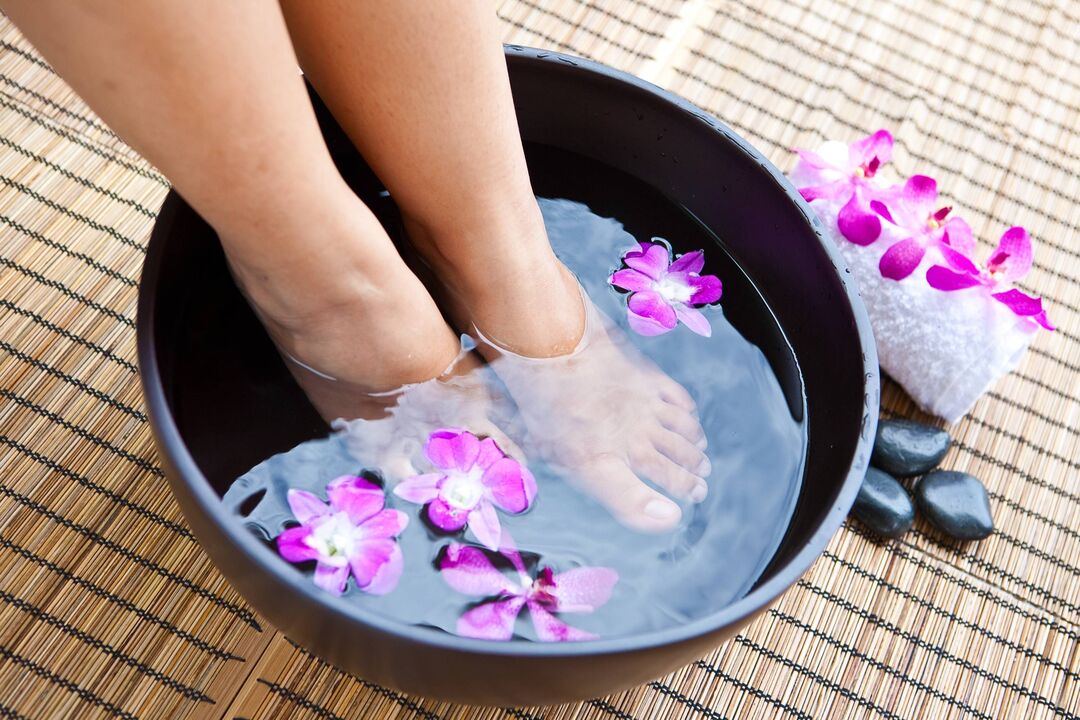
Infection with pathogenic fungi occurs through contact, as well as through poor hygiene. Onychomycosis (fungus of the nail plate) is most often contracted through the use of common shoes in everyday life, in gyms and other places with high humidity and temperature. The initial stage of toenail fungus has certain signs. Recognizing them, it is possible to avoid passing the pathology to another stage of development.
All folk remedies can be used only after consulting a dermatologist. Many of them can cause allergic reactions. It is easier to cure onychomycosis by combining alternative cures with medications.
In the initial stage, toenail fungus appears as almost invisible furrows or white dots. Often a person learns that he or she has a fungal infection only when they visit a dermatologist. This is explained by the fact that it is almost impossible to recognize the disease yourself during this period. If the therapy is started on time, the disease is cured quickly.
Fungus (onychomycosis) is not only a dermatological disease, but in advanced forms many internal systems and organs are affected. In order to immediately stop the pathology, you need to know the symptoms and treatment methods. How does the disease appear in different stages? Which medications are most effective?
You can get infected with the fungus at home if someone in your family has it; everyone uses the same pedicure or manicure kit. But in public places the risk of infection is much higher - fungi live in bathrooms, swimming pools and showers in fitness centers.
What diseases can provoke fungal infection:
- flat feet, congenital or acquired foot deformity;
- poor blood circulation in the lower extremities;
- increased sweating of the feet;
- corns, excessively rough skin on legs;
- frequent injuries to the nail plate;
- weakened immunity, any chronic disease, diabetes.
Foot fungus often develops among lovers of tight shoes and people who neglect the rules of personal hygiene. Infection often occurs in beauty salons where the instruments are poorly processed. The disease can be provoked by taking oral contraceptives and antibacterial drugs.
Preventive measures
To avoid the disease, it is necessary:
- Avoid direct contact with fungus carriers.
- Respect the rules of personal hygiene, wash your hands after visiting public places.
- After washing, carefully wipe the areas between the toes, as the fungus loves a warm and moist environment.
- Do not use other people's shoes and household items.
- Wear socks made from natural fabrics.
- Wear shoes in a public pool, spa or sauna.
- Use personal manicure accessories.

prediction
The prognosis for timely diagnosis and adequate treatment of nail fungus is favorable. Against the background of accompanying chronic diseases, the prognosis worsens.
Treatment for advanced nail fungus is long-term. Recurrences occur in 40-70% of cases.
















